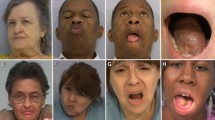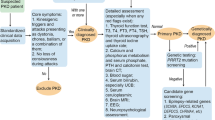Abstract
Although there is a consensus that orofacial and limbtruncal subtypes of tardive dyskinesia (TD) exist and may represent distinct pathophysiologic entities, few studies have examined the incidence of and risk factors associated with the development of these TD subtypes. Two hundred and sixty-six middle-aged and elderly outpatients with a median duration of 21 days of total lifetime neuroleptic exposure at study entry were evaluated at 1- to 3-month intervals. Using “mild” dyskinesia in any part of the body for diagnosis of TD, the cumulative incidence of orofacial TD was 38.5 and 65.7% after 1 and 2 years, respectively, whereas that of limbtruncal TD was 18.6 and 32.6% after 1 and 2 years. Preclinical dyskinesia was predictive of both orofacial and limbtruncal TD. History of alcohol abuse or dependence was a significant predictor of orofacial TD only whereas tremor was a significant predictor of limbtruncal TD only. Findings support suggestions that orofacial and limbtruncal TD may represent specific subsyndromes with different risk factors.
Similar content being viewed by others
References
American Psychiatric Association (1987) Diagnostic and statistical manual of mental disorders, Third Edition, Revised. American Psychiatric Press, Washington, DC
American Psychiatric Association (1994) Diagnostic criteria from DSM-IV. American Psychiatric Association, Washington, DC
Arendt T, Bigl V, Arendt A, Tennstedt A (1983) Loss of neurons in the nucleus basalis of Meynert in Alzheimer's disease. Acta Neuropathol 61: 101–108
Baldessarini RJ, Cole JO, Davis JM, Gardos G, Preskorn SH, Tarsy D (1980) Tardive dyskinesia: a task force report of the American Psychiatric Association. American Psychiatric Association, Washington, DC
Brown KW, White T (1991) The association among negativesymp toms, movement disorders, and frontal lobe psycholo gical deficits in schizophrenic patients. Biol Psychiatry 30: 1182–1190
Brown KW, White T (1992) The influence of topography on the cognitive and psychopathological effects of tardive dyskinesia. Am J Psychiatry 49: 1385–1389
Butters N, Wolfe J, Martone M, Granholm E, Cermak LS (1985) Memory disorders associated with Huntington's disease: verbal recall, verbal recognition and procedural memory. Neuropsychologia 23: 29–743
Caligiuri MP, Lohr JB (1993) Worsening of postural tremor in patients with levodopa-induced dyskinesia: a quantitative analysis. Clin Neuropharmacol 16: 244–250
Caligiuri MP, Lohr JB, Bracha HS, Jeste DV (1991a) Clinical and instrumental assessment of neuroleptic-induced parkinson ism in patients with tardive dyskinesia. Biol Psychiatry 29: 139–148
Caligiuri MP, Lohr JB, Jeste DV (1991b) Instrumental evidence that age increases motor instability in neuroleptic-treated patients. J Gerontol 46: B197-B200
Casey DE (1988) Affective disorders and tardive dyskinesia. L'Encephale 14: 221–226
Casey De, Denney D (1977) Pharmacological characterization of tradive dyskinesia. Psychopharmacology 54: 1–9
cassey DE, Gerlach J (1986) Tardive dyskinesia: what is the longterm outcome? In: Casey DE, Gardos G (eds) Tardive dyskinesia and neuroleptics: from dogma to Reason. American Psychiatric Press, Washington, DC pp 75–97
Collett D (1994) Modelling survival data in medical research. Chapman and Hall, London
Cancato J, Feinstein AR, Holford TR (1993) The risk of determining risk with multivariable models. Ann Int Med 118: 201–210
Cox DR (1972) Regression models and life tables. J R Statist Soc Ser B 34: 187–220
Crane GE (1972) Pseudoparkinsonism and tardive dyskinesia. Arch Neurol 27: 426–430
Crane GE (1974) Factors predisposing to drug-induced neurologic medication. In: Forrest IS, Carr CJ, Usdin E (eds) The phenothiazines and structurally related drugs. Raven Press, New York, pp 269–279
Cutler SJ, Ederer F (1958) Maximum utilization of the life table method in analyzing survival. J Chron Dis 8: 669–712
Dixon, L, Weiden PJ, Haas G, Sweeney J, Francese AJ (1992) Increased tardive dyskinesia in alcohol-abusing schizophrenic patients. Comp Psychiatry 33: 121–122
Dixon WJ (chief ed.) (1992) BMPD statistical software manual (vol. 1 and vol. 2). University of California Press, Berkeley
Duke PJ, Pantelis C, Bames TR (1994) South Westminster schizophrenia survey: alcohol use and its relationship to symptoms, tardive dyskinesia and illness on set. Br J Psychiatry 164: 630–636
Folstein MF, Folstein SE, McHugh PR (1975) Mini-Mental State: a practical method for grading the cognitive state of patients for the clinician. J Psychiatr Res 12: 189–198
Ganzini L, Casey DE, Hoffman WF, Heintz RT (1991a) Tardive dyskinesia in neuroleptic-treated diabetics. 30th Annual Meeting of the American College of Neuropsychopharmacology: Abstracts of Panels and Posters, p 162
Ganzini L, Heintz RT, Hoffman WF, Casey DE (1991b) The prevalence of tardive dyskinesia in neuroleptic-treated diabetics: a controlled study. Arch Gen Psychiatry 48: 259–263
Gardos G, Cole JO, Haskell D, Marby D, Paine SS, Moore P (1988) The natural history of tradive dyskinesia. J Clin Psychopharmacol 8: 31S-37S
Glazer WM, Morgenstern H (1988) Predictors of occurrence, Severity, and course and tardive dyskinesia in an outpatient population. J Clin Psychopharmacol 8: 10S-16S
Grant I (1987) Life events do not predict symptoms predict symptoms. J Behav Med 10: 231–240
Gureje O (1988) Topographic subtypes of tardive dyskinesia in schizophrenic patients aged less than 60 years: relationship to demographic, clinical, treatment, and neuropsychological variables. J Neurol Neurosurg Psychiatry 51: 1525–1530
Gureje O (1989) The significance of subtyping tardive dyskinesia: a study of prevalence and associated factors. Psychol Med 19: 21–128
Hamilton M (1967) Development of a rating scale for primary depressive illness. Br J Soc Clin Psychol 6: 278–296
Hansen TE, Casey DE, Vollmer WM (1986) Is there an epidemic of tardive dyskinesai? In: Casey DE, Gardos G (eds) Tardive dyskinesia and neuroleptics: from dogma to reason. American Psychiatric Press, Washington, DC pp 1–14
Jeste DV, Caligiuri MP (1993) Tardive dyslinesia. Schizophr Bull 19: 303–315
Jeste DV, Wyatt, RJ (1982) Understanding and treating tardive dyskinesia. Guilford Press, New York
Jeste DV, Lohr JB, Kaufmann CA, Wyatt RJ (1986) Pathophysiology of tardive dyskinesia: evaluation of supersensitivity theory and alternative hypotheses. In: Casey D, Gardos G (eds) Tardive Dyskinesia: from dogma to reason. American Psychiatric Press, Washington, DC, pp 15–32
Jeste DV, Caligiuri MP, Paulsen JS, Heaton RK, Lacro JP, Harris MJ, Bailey A, Fell RL, McAdams LA (1995) Risk of tardive dyskinesia in older patients: a prospective longitudinal study of 266 patients. Arch Gen Psychiatry 52:756–765
Kane JM, Smith JM (1982) Tradive dyskinesia: prevalence and risk factors, 1959 to 1979. Arch Gen Psychiatry 39:473–481
Kane JM, Woerner M, Lieberman J (1988) Tardive dyskinesia: prevalence, incidence, and risk factors. J Clin Psychopharmacol 8 [4]:52S-56S
Kane JM, Jeste DV, Barmes TRE, Casey DE, Cole JO, Davis JM, Gualtieri CT, Schooler NR, Sprague RL, Wettstein RM (1992) Tardive dyskinesia: a task force report of the American Psychiatric Association. American Psychiatric Association, Washington DC
Khot V, Wyatt RJ (1991) Not all that moves is tardive dyskinesia. Am J Psychiatry 148:661–666
Kidger T, Bames TRE, Trauer T, Taylor PJ (1980) Sub-syndromes of tradive dyskinesia. Psychol Med 10:513
Klawans H, Rubovits R (1974) Effect of cholinergic and anticholinergic agents on tardive dyskinesia. J Neurol Neurosurg Psychiatry 27:941–945
Koller WC, Vetere-Overfield B, Barter R (1989) Tremors in early Parkinson's disease. Clin Neuropharmacol 12:293–297
Lieberman J, Lesser M, Johns C, Pollack S, Saltz B, Kane J (1988a) Pharmacologic studies of tardive dyskinesia. J Clin Psychopharmacol 8:57S-63S
Lieberman J, Pollack S, Lesser M, Kane J (1988b) Pharmacologic characterization of tardive dyskinesia. J Clin Psychopharmacol 8:254–257
Lohr J, Wisniewski A, Jeste DV (1986) Neurological aspects of tardive dyskinesia. In: Nasrallah HA, Weinberger DR (eds) The neurology of schizophrenia. Elsevier Science Publishers, Amsterdam, pp 97–119
Lucey JL, Dinan TG (1992) Orofacial dyskinesia and the alcohol dependence syndrome. Psychol Med 22:79–83
Mahadik SP, Laev H, Korenovsky A, Karpiak SE (1988) Haloperidol alters rat CNS cholingergic system: enzymatic and morphological analyses. Biol Psychiatry 24:199–217
Morgenstern H, Glazer WM (1993) Identifying risk factors for tardive dyskinesia amoong long-term outpatients maintained with neuroleptic medications: results of the Yale Tardive Dyskinesia Study. Arch Gen Psychiatry 50:723–733
Mukerjee S, Reddy R, Schnur DB (1991) A developmental model of negative syndromes in schizophrenia. In: Greden JF, Tandon R (eds) Negative schizophrenic symptoms: pathophysiology and clinical implications. American Psychiatric Press, Washington, DC, pp 173–186
National Institute of Mental Health (1975) Abnormal involuntary movement scale (AIMS). Early Clinical Drug Evaluation Unit Intercom 4:3–6
Olivera AA, Kiefer MW, Manley NK (1990) Tardive dyskinesia in psychiatric patients with substance use disorders. Am J Drug Alcohol Abuse 16 [1&2]:57–66
Oscar-Berman M (1987) Neurophychological consequences of alcohol abuse: questions, hypotheses and models. In: Parsons OA, Butters N, Nathan PE (eds) Neuropyschology of alcoholism: implications for diagnosis and treatment. The guilford Press, New York, pp 256–269
Overall JE, Gorham DR (1962) The Brief Psychiatric Rating Scale. Psychol Rep 10:799–812
Overall JE, Gorham DR (1988) The Brief Psychiatric Rating Scale (BPRS): recent developmenta in ascertainment and scalling. Psychopharmacol Bull 24:97–99
Paulsen JS, Heaton RK, Jeste DV (1994) Neuropsychological impairment in tardive dyskinesia. Neuropsychology 8 [2]:227–241
Porjesz B, Begleiter H (1987) Evoked brain potentials and alcoholism. In: Parsons OA, Butters N, Nathan PE (eds) Neuropsychology of alcoholism: implications for diagonsis and treatment. The Guilford Press, New York, pp 45–63
Risberg J, Berglund M (1987) Cerebral blood flow and metabolism in alcoholics. In: Parsons OA, Butters N, Nathan PE (eds) Neuropsychology of alcoholism: implications for diagnosis and treatment. The Guilford Press, New York, pp 64–75
Ryan C, Butters N (1980) Alcoholism and Premature aging: a neuropsychological perspective. Alcohol Clin Exp Res 6:79–96
Saltz BL, Woemer MG, Kane JM, Lieberman JA, Alvir JM, Bergmann KJ, Blank K, Koblenzer J, Kahaner K (1991) Prospective study of tardive dyskinesia incidence in the elderly. JAMA 266:2402–2406
Sandyk R (1990) Pineal calcification and subtypes of tardive dyskinesia. Int J Neurosci 53:223–229
Sandyk R, Kay SR (1991) The relationship of tardive dyskinesia to positive schizophreniua. Int J Neurosci 56:107–139
Sandyk R, Pardeshi R (1990) Mood-depressant fluctuations in the severity of tardive dyskinesia and psoriasis vulgaris in a patient with schizoaffective disorder: possible role of metatonin. Int J Neurosci 50:215–221
Schneider JS (1989) Levodopa induced dyskinesia in parkinsonian monkeys: relationship to extent of nigrostriatal damage. Pharmacol Biochem Behav 34:193–196
Schooler N, Kane JM, (1982) Research diagnoses for tardive dyskinesia. Arch Gen Psychiatry 39:486–487
Sewell DD, Yoshinobu BH, Caligiuri MP, Jeste DV (1992) Metoclopramide-associated tardive dyskinesia in hemodialysis patients with diabetes mellitus: two case reports. Gen Hosp Psychiatry 14:416–419
Shaw TG (1987) Alcohol and brain function: an appraisal of cerebral blood flow data: Parsons OA, Butters N, Nathan PE (eds) Neuropsychology of alcoholism: implications for diagnosis and treatment. The Guilford Press, New York, pp 129–152
Simpson GM, Angus JW (1970) A rating scale for extrapyramidal side effects. Acta Psychiatr Scand 45 [s212]:11–12
Simpson GM, Lee JH, Zoubok B, Gardos G (1979) A rating scale for tardive dyskinesia. Psychophamacology 64:171–179
Tarsy D, Granacher R, Bralower M (1977) Tardive dyskinesia in young adults. Am J Psychiatry 134:1032–1034
Waddington JL, Youssef HA (1986) An unusual cluster of tardive dyskinesia in schizophrenia: association with cognitive dysfunction and negative symptoms. Am J Psychiatry 143:1162–1165
Wilkson DA (1987) CT scan and neuropsychological assess ments of alcoholism. In: Parsons OA, Butters N, Nathan PE (eds) Neuropsychology of alcoholism: implications for diagnosis and treatment. The Guilford Press, New York, pp 76–102
Williams HL (1987) Evoked brain potentials and alcoholism: questions, hypotheses, new approaches. In: Parsons OA, Butters N, Nathan PE (eds) Neuropsychology of alcoholism: implications for diagnosis and treatment. The Guilford Press, New York, pp 103–128
Woerner MG, Saltz BL, Kane JM, Lieberman JA, Alvir MJ (1993) Diabetes and development of tardive dyskinesia. Am J Psychiatry 150:966–968
Wolf ME, DeWolfe AS, Ryan JJ, Lips O, Mosnaim AD (1985) Vulnerability to tardive dyskinesia. J Clin Psychiatry 46:367–368
Yassa R, Jeste DV (1992) Gender differences in tardive dyski nesia: a critical review of the literature. Schizophr Bull 18 [4]:701–715
Yassa R, Lal S, Korpassy A, Ally J (1987) Nicotine exposure and tardive dyskinesia. Biol Psychiatry 22:67–72
Author information
Authors and Affiliations
Rights and permissions
About this article
Cite this article
Paulsen, J.S., Caligiuri, M.P., Palmer, B. et al. Risk factors for orofacial and limbtruncal tardive dyskinesia in older patients: a prospective longitudinal study. Psychopharmacology 123, 307–314 (1996). https://doi.org/10.1007/BF02246639
Received:
Revised:
Issue Date:
DOI: https://doi.org/10.1007/BF02246639




